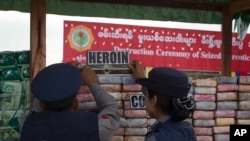The evergreen hills of northeast Myanmar’s section of the Golden Triangle are sparse, making it easy to hide out in the open a set of machines that look like squat robots, but are in fact pressure reactors that cook drug chemicals. Authorities revealed last week they had seized the reactors, along with opioids, 193 million meth tablets and other narcotics in what the United Nations called one of the biggest drug busts in Asian history.
A new type of drug for the region
Burmese and foreigners were among the 33 people arrested in the raid, said to be unprecedented for not only the volume of drugs confiscated, but also the presence of fentanyl. This appears to be the first time officials in the region have seized fentanyl and related opioids, which are the substances linked to hundreds of thousands of deaths in the North American opioid crisis. The Golden Triangle of Myanmar, Thailand and Laos is historically known for rivaling Afghanistan for its heroin trade, but this month’s drug bust marks a potential shift toward synthetic opioids.
Colonel Zaw Lin, law enforcement chief at Myanmar’s Central Committee for Drug Abuse Control, said he was “pleased” at the success of the joint operation with the U.N. Office on Drugs and Crime. It gives the Southeast Asian government a legal victory at a time when it is otherwise weighed down by an onslaught of crises, including COVID-19, Rohingya Muslim refugees and journalists’ imprisonment.
However there is more work to be done following the drug raid, according to the colonel.
“We are well aware of the challenges we face,” Colonel Zaw Lin said. “Criminal groups, traffickers and corrupt accomplices must and will be brought to justice.”
Rainbow of drugs
Myanmar’s military and police worked with the U.N. office on the investigation, which they said was linked to organized crime and militias. On the fawn grasses of Shan State, law enforcement laid out a rainbow of their findings: crystal methamphetamine disguised in neon green tea bags, yellow sacks of meth pills, a field’s worth of blue plastic barrels of chemicals.
Officials fear the findings, which include 3,700 liters of methyl fentanyl, suggest Asia could be on the cusp of its own synthetic opioid problem.
“What has been unearthed through this operation is truly off the charts,” Jeremy Douglas, the regional representative for Southeast Asia and the Pacific at the UNODC, said of the volume of narcotics.
“We have been projecting this scenario for a few years, and we are now able to say it is happening,” he said.
Authorities seized guns, as well as lab equipment and 39 kinds of chemicals they said had been routed through China, India, Thailand, Vietnam and Laos.
They also said that they seized heroin, opium and morphine, but that the farming of poppy flowers used to make those products has been on the decline for years, suggesting a shift to synthetic drugs instead.
What began with a relatively small discovery of meth pills, the UNODC said in a press release, ultimately led to a series of raids from February to April, ending with tons of narcotics seized and dozens arrested.
Colonel Zaw Lin said that he hopes neighboring nations would take equally aggressive action and that his message to traffickers is that “their days of operating in Myanmar are numbered.”







